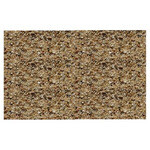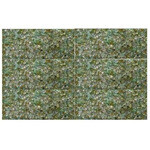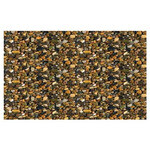Filtration Media. Volume vs Weight.

Silica sand - The most popular choice of Media for Pool Sand filter. It comes from ground quartz, which creates sharp silica grains. Each grain should be the same in order to effectively trap particulates from passing though water. Filter particles: 20-40 micorn. Filtration level: Top (approx. 6”).
Lower initial costs. Lower cost of replacement but more frequent change (every 3-5 years).

Glass Media – is an alternative option for Silica Sand. Relatively new (introduced in 1990) but an effective filtration media. It is made from 100% recycled glass (smooth to the touch surface) with negative charge (captures iron and manganese particles) - excellent when pool is filled from a hard water source. Filter Particles: As small as 5 micron. Filtration level: All Levels. Lifespan: 5-10 years.
Higher initial cost, long term savings. Energy/water Saving Solution

Pea Gravel – more common in commercial settings due to higher bather load and greater requirements for performance from the filter media. Ideally there should be no more than 1” over the laterals (protection laterals from the Sand weight). Helps with filtering out sand before it reaches the lateral system which in turn also eliminates bacteria that might be forming underneath the system.
When do I need to change the Silica Sand in my Sand Filter?
Over the course of years, the contamination of the Sand builds up which has an effect on filtration of pool water. The efficiently of the filtration drops and the water quality suffers. Water that cannot find a way through the clogged-up sand builds up the pressure within the filter. It may also lead to the water seeking a path of least resistance and cut channels through the sand (reduce some of the pressure) but will virtually eliminate filtering.
Short Term Solution: Importance of Backwash
Backwashing is an important part of your routine pool maintenance. It’s the way of rinsing the sand and flushing is from build-up debris. This is also required whenever the pressure gauge climbs higher than the normal running pressure. It is also recommended if the water is a bit cloudy, but the chemistry is okay. Remember to check the level of water afterwards. You might need to top it up.
Filter cleaner (extra cleaner – used annually). It helps to wash out oils and other contaminants that backwashing cannot quite get rid of.
Both backwashing and filter cleaner helps out with climbing pressure and water clarity, but eventually the sand will wear down and you will need to replace it.
Volume vs Weight
When replacing the sand in the filter we change weight for weight with the same type of filtration media. This is specific to each of the models and can be found in the manual of your filter.
What should we consider if we decide to change sand filter media? Check filter Manual (or contact manufacturer) for recommendation. Different media has different densities. Hence weight may vary, volume always stays constant. Bear in mind that in most cases it will be possible but there are some exceptions.
How many kilograms does my filter take?
Example: You have a 30-litre box and you fill it with 30 litres of water (that might weight 30kg). The combined weight (the box and the water) will be much higher than 30kg. At the same time the Volume of both has not changed. It is still 30-litre.
Similarly, all Filters have a set volume that must be achieved within the tank. The weight may be different depending on filter media. Density of glass is lower than the Sand.
Common Mistake to Avoid: If your Sand Filter normally takes 100kg of sand but you fill it with 100kg of Glass, it will have wrong quantity. Glass, lower density, has approximately 20% less volume by weight than sand.
Example: Waterco 24inch - filter takes 106 litres of media. That is 155 kg of sand. That is 171 kg of glass beads. And that is 127 kg of zeolite.
“In water treatment circles, you normally talk about the volume of a filter by litres, but in the pool industry, we always talk about [filter size] by weight. So, we’ve got to be conscious of the kilograms-to-litres ratio to ensure we put the right amounts in.” – Bryan Goh. (Waterco Limited for Pool + Spa,2014)

